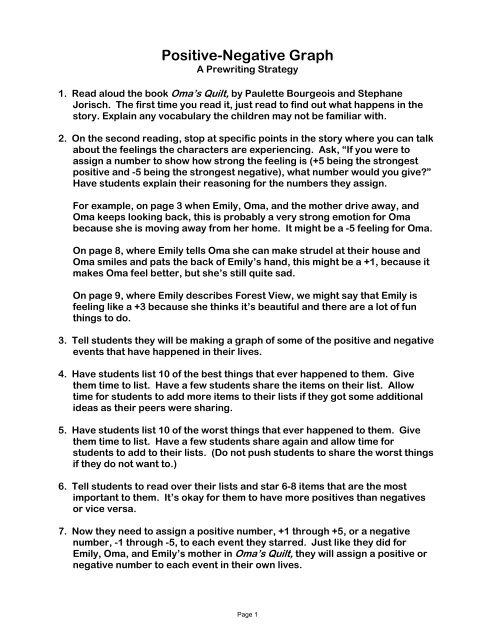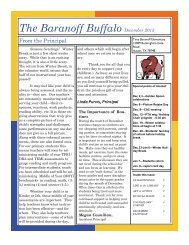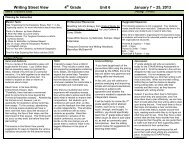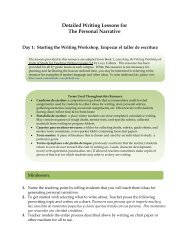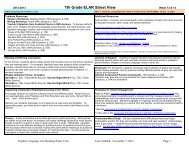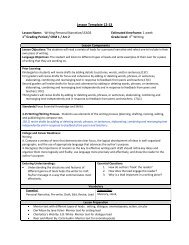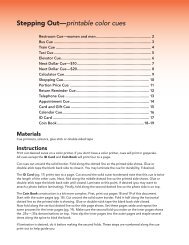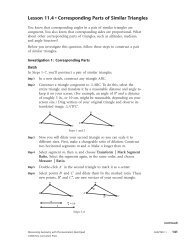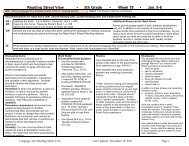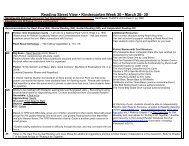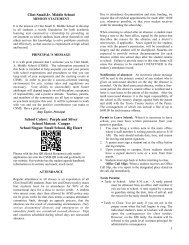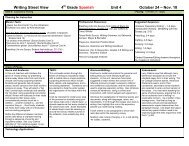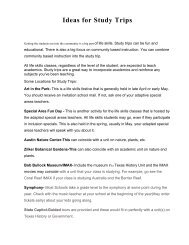Positive-Negative Graph
Positive-Negative Graph
Positive-Negative Graph
Create successful ePaper yourself
Turn your PDF publications into a flip-book with our unique Google optimized e-Paper software.
<strong>Positive</strong>-<strong>Negative</strong> <strong>Graph</strong>A Prewriting Strategy1. Read aloud the book Oma’s Quilt, by Paulette Bourgeois and StephaneJorisch. The first time you read it, just read to find out what happens in thestory. Explain any vocabulary the children may not be familiar with.2. On the second reading, stop at specific points in the story where you can talkabout the feelings the characters are experiencing. Ask, “If you were toassign a number to show how strong the feeling is (+5 being the strongestpositive and -5 being the strongest negative), what number would you give?”Have students explain their reasoning for the numbers they assign.For example, on page 3 when Emily, Oma, and the mother drive away, andOma keeps looking back, this is probably a very strong emotion for Omabecause she is moving away from her home. It might be a -5 feeling for Oma.On page 8, where Emily tells Oma she can make strudel at their house andOma smiles and pats the back of Emily’s hand, this might be a +1, because itmakes Oma feel better, but she’s still quite sad.On page 9, where Emily describes Forest View, we might say that Emily isfeeling like a +3 because she thinks it’s beautiful and there are a lot of funthings to do.3. Tell students they will be making a graph of some of the positive and negativeevents that have happened in their lives.4. Have students list 10 of the best things that ever happened to them. Givethem time to list. Have a few students share the items on their list. Allowtime for students to add more items to their lists if they got some additionalideas as their peers were sharing.5. Have students list 10 of the worst things that ever happened to them. Givethem time to list. Have a few students share again and allow time forstudents to add to their lists. (Do not push students to share the worst thingsif they do not want to.)6. Tell students to read over their lists and star 6-8 items that are the mostimportant to them. It’s okay for them to have more positives than negativesor vice versa.7. Now they need to assign a positive number, +1 through +5, or a negativenumber, -1 through -5, to each event they starred. Just like they did forEmily, Oma, and Emily’s mother in Oma’s Quilt, they will assign a positive ornegative number to each event in their own lives.Page 1
8. Students will now plot their events on a timeline, with time in either ages oryears on the x-axis, and positive/negative numbers on the y-axis. As always,it will work best if you show students with your own example how to plot yourevents before they begin their graphs. Leave your timeline on display forstudents to reference as they work.9. Students may add a quick, simple drawing next to each event to make thegraph more visually appealing and to draw them into the memory morevividly.10. Students choose an event from their graph to free write about.Note: Students should return to this graph again and again to find importantstories from their lives to write about in the future. Remind them to review thisgraph the next time they say they don’t know what to write about!Adapted from Linda Rief’s <strong>Positive</strong>-<strong>Negative</strong> <strong>Graph</strong> in Seeking Diversity, p. 48-50.Page 2
BlueprintingIn this prewriting strategy, writers draw the floor plan of a house, apartment, orroom that is important to them. By drawing the floor plan, then labeling therooms and items contained within the rooms, writers are lured into the memoriesof special times in this house, apartment or room.1. Teacher shows examples of floorplans for new homes found innewspapers or real estateadvertisements. Explain that floor plansare a ‘bird’s eye view’ of the rooms insidea house.2. Sketch a floor plan of a house,apartment, or room that is important toyou.3. Students begin a sketch of their ownfloor plans.4. Using your floor plan as a model, show students how to label the rooms. Asyou label the rooms (kitchen, family room, my bedroom, etc.) and a few of thelarger items in a room or two (bed, book shelf, dresser, closet, etc.), tell a few ofthe memories that come to mind.5. Allow time for students to continue drawing and labeling their rooms anditems in their rooms. When most students are close to completing their drawings,stop them to watch and listen as you model the next step.6. Teacher goes to another part of the paper and uses the labels of the rooms ascolumn headings. Under the column headings, list words, phrases, sentences,names, or activities that represent your memories of these special places. You donot need to complete one list before moving on to another. Jump around fromone column to another as memories spark other memories, and jot down yourthoughts as quickly as they present themselves in your mind.(For example, “living room” might produce the phrases: coffee table, trying to kill awasp and falling off the couch, hitting my elbow on the coffee table, the birthdayparty when we moved the furniture away from the center of the room to make adance floor, Dad sleeping and snoring on the couch while watching the news,etc.)7. Allow time for students to add words and phrases to their columns.Page 3
8. When writers have written all the words, phrases, and memories they can, theyreread their lists, looking for connections between items in their lists. They circlethe items that connect and draw a line to show the connection.For example, birthday party may connect to the (kitchen) tradition of bakingbirthday cakes for every birthday in our family, and hitting my elbow on the coffeetable may connect to playing card games on the coffee table, etc.9. Students free write about the connections they made or any story that calls tothem to be written today.Blueprinting is a prewriting strategy by Peter Stillman.From Joyce Armstrong Carroll and Edward E. Wilson, Acts of Teaching, 2 nd Ed., p. 17Page 4
The Reading/Writing ConnectionUsing Picture Books to Generate IdeasWriters need to find the stories that are important intheir lives. Sometimes the literature we read can helpthem uncover those stories. Picture books, poems, andshort texts are a major inspiration for students to begintelling their stories. Carefully chosen texts can“magically awaken the stories that lay waiting to betold.” (Davis and Hall, p. 56)When selecting texts to read aloud, try to choose books to which yourstudents will relate, to enable them to see their experiences in new ways.Choose books that have characters that will inspire students and experiencesthat make the children understand the importance of their own experiences.The books we choose also provide a model for students to internalize the ebband flow of the way stories are told, to help them become better oralstorytellers. We want them to transfer this sense of story to the writing oftheir own stories.As writers make connections and begin telling their stories, we need to showthat we value their experiences and encourage them to share the details ofeven the smallest of stories. Ask students to tell their stories in a way thatshows why this story is important to them. Encourage listeners to be a goodaudience and ask probing questions to motivate the storyteller to get to theheart of their story.Highlight connections students might make that are surprising and, at firstglance, seem unrelated. This teaches children that our minds are makingconnections all day, every day, and that every connection has the potential tobe a story with importance and should be written in the Writer’s Notebook.We want to push students to make interesting connections and to ponder themeaning of those connections.A Minilesson:Choose a powerful picture book and chart the possible different ways toconnect to the story. For instance, one writer might relate to a similarexperience and tell that story. Another might relate to the topic. Still anothermight relate to the feelings evoked by the book. Others might connect to thebigger issues underlying the story. Some might connect to a word or phrasethat triggers a response. One might relate to a particular character thatPage 5
eminds them of someone they know. One could relate to the place.Encourage students to try to envision different ways in which they may relateto texts they have read, things they have seen or heard, entries they havepreviously written.Following are two examples of beautiful children’s books and the wayschildren have responded to each story.The Sunsets of Miss Olivia Wiggins, by Lester L. LaminackThis is a charming story that showcases one Miss Olivia, who seems not to be aware of the events happeningaround her; neverthelewss, when her daughter and her great-grandson come to the nursing home to visit,they are able to stir up some pleasant memories of her past.Students shared the following responses:• The way the world appears to someone who might not be able to hearwell• A lot of people have memories of holding babies• How I had to get used to holding my baby brother when he was younger• Watching the sun set• I wonder if I am too old to be playing with dolls and stuffed animals• How I loved to listen to the song my mother made up and sang to me atbedtime• When I am older, will I remember the things I do now?• What makes a person forget when they get older?Camping, by Nancy HundalThe story unfolds when a family packs up and heads for a campground. From the moment their camp fire isestablished, the family slowly begins to discover the wonders of life in the wild—quiet nights, star gazing,cooking over a fire, swimming in the lake, climbing trees, and just lolling in the sun.Students ponder:• How I am an expert at toasting marshmallows• How much fun it is to sleep in a tent• When things that you might not want to do turn out to be fun• Swimming in the cold lake• Not always getting your way• Things don’t have to cost a lot of money to be fun• The sounds I hear at night when I am trying to go to sleep• I never get a chance to just do nothing because my mom thinks it’s not agood thing• Making tents in my bedroomJudy Davis & Sharon Hill, The No-Nonsense Guide to Teaching Writing (2003)Page 6
Watermelon Vs. Seed StoryMinilesson:1. Tell children that today’s teaching point will begin with focus.2. Teacher explains that when we think of a topic and then list specific instances,sometimes those specific instances are still too big.3. Writers know that to write a story that draws readers close to listen, it helps to writeabout a small episode, something that happened in twenty minutes, or even in justthree minutes! It is important to zoom in on one small story and to tell the parts ofthe story that matter, leaving out sections that don’t matter. Writers retell thesequence of events in our stories, writing with details, telling the story in a step-bystepway.4. Teacher creates a chart titled Qualities of Good Personal Narrative Writing and posts itfor all to view.Qualities of Good Personal NarrativeWriting• Write a little seed story, don’t write allabout a giant watermelon topic.• Zoom in so you tell the most importantparts of the story.5. Together, discuss how the first bullet point helps us think about not only what we’regoing to write about but also how we’ll write our stories so that they really affect ourreaders. Usually when we think of a person, place, or object, for example, whatcomes to mind first are great big watermelon topics. To get to a really good story, ithelps to select a particular, smaller subject, and tell not a watermelon story but alittle seed story. Teacher provides explicit models to demonstrate the differencebetween watermelon topics and seed stories.Possible ideas for identifying watermelon vs. seed:Page 7
o Possible ideas for identifying watermelon vs. seed:• Fun times I have with my dog(watermelon)• When I spotted my dog at the poundand realized he was the one for me(seed)• When the person who is now my bestfriend arrived in our classroom and wemet each other for the first time. (seed)• My best friend (watermelon)• The year I was on the soccer team andwe won six games and lost two(watermelon)• The time Susan and I found a quarterthat had been frozen in ice and wechipped it out (seed)Active Engagement:6. Students will practice distinguishing between big topics and focused stories. Teacherwill provide a series of ideas and ask students to identify either watermelon or seedstory.7. Together with a writing partner, students look over the entries in their notebooksand identify “watermelon story” or “seed story”8. Encourage those students who have written watermelon topics to look for possibleseed stories within.9. Allow students time to explore and develop their identified seed stories from anylarger topics they may have written (watermelon topics).Share/Reflect:10. Convene the group and have students sit with a writing partner.11. Students share any additions they have made and Teacher notes possible exemplarsof students who have developed a seed story.Page 8
Writing with Specific DetailsMinilesson:1. Tell children that today’s teaching point will begin with writing with specific details.2. Teacher selects an exemplar from the class that shows how a student extendedhis/her own writing by telling exact details. As a result, the student may havecreated a movie in his/her head.3. Teacher provides a specific example to help students understand this idea. Onepossible idea might be to show how a photographer zooms in on one tiny part of alarger picture. For example, instead of photographing a whole meadow, aphotographer might just zoom in on three daisies within that meadow.Active Engagement:4. Students work with a writing partner to check for places in their own writing wherethey could apply this technique of using exact details.5. Students return to their writing area and work on adding exact details to theirwriting.6. Teacher circulates and provides support as needed, reminding students that “truedetails” need not to have specifically occurred in the event, but if they make sense inthe context of the story, the author has the license to include them.Share/Reflect:7. Teacher adds to the criteria chart and reminds students to use this chart periodicallyin their writing to extend their sentences.8. Students share with a writing partner the places where they have added exactdetails.Qualities of Good Personal NarrativeWriting• Write a little seed story, don’t write allabout a giant watermelon topic.• Zoom in so you tell the most importantparts of the story.• Include true*, exact details from the movieyou have in your head.* (True details need not have specificallyoccurred in the episode, and the author hasliterary license to include them if they arerealistic).Page 9
Choosing a Seed IdeaMinilesson:1. Tell students you’ll teach them to choose one entry to develop into a publishablepiece. Today I want to teach you that writers don’t just write one entry and then writeanother and another as we have been doing. As writers, after we collect entries and ideas for awhile, we reread and we find one story, one entry that especially matters to us and we make acommitment to that one entry. We decide to work on it so it becomes our very best writingever.2. Using Roxaboxen or any favorite narrative text as a reference, explain to the studentsthat writing allows authors: to take the stuff that is all around them in their lives – thelittle stories – and hold one small piece of life in their hands, declaring it a treasure.3. Model how you go back to your entries and you reread them and think aboutwhether one of your entries might be worth developing into a story that you’d like topublish.Active Engagement:4. Ask students to tell their partner three specific things they saw you doing in order tochoose an entry that mattered to you.5. Restate the goal for today’s writing time: Today, and whenever it is time for you to stopcollecting entries and begin working on one writing project, remember that you – like writerseverywhere – can reread your entries and think, ‘Which of these really matters?’ Look forentries that draw you in, that seem to be saying, ‘Pick me!’6. Students work in their writer’s notebooks to choose a seed idea to develop into apublished piece.Share/Reflect:7. Provide time for students to read books and stories that remind them of what theywant to write.With your seed idea in mind, take some time to read one of these books. Read it and reread ituntil you get the sound and the feeling in your bones. Feel the mood and the shape. You’llwant to feel that so that you can create it with the entry you’ve chosen.See chart on the next page.Page 10
Choosing a Seed Idea• Carefully reread all of your entries.• Ask yourself, ‘Does this really matter to me?Does it say something about me?’• Star the entries that seem like possibilities.• Come back to all the starred entries and choosethe one that’s saying ‘Choose me!’• Choose the entry that you have a lot to sayabout.Adapted from Book 1, Launching the Writing Workshop of Units of Study for Teaching Writing Grades 3-5by Lucy Calkins.Page 11
Choosing Ideas from the NotebookJudy Davis and Sharon Hill, in their book The No-Nonsense Guide to TeachingWriting, say:“It is important to demonstrate for students how to closely reread theirnotebooks for entries that seem to “jump out” at them and how to identify theones they might possibly work on for publication. As students spend some timemaking this decision, they may use sticky notes to tab the pages that hold thepossible ideas they’d like to work with.” (p. 84)In a minilesson, develop criteria that students might use as they review theirnotebooks to choose an idea to publish.Reasons for Choosing Something to Publish:• You think an entry is important and you have already written a lot.• You realize an entry is not your best writing, but you know youhave more to say and would like to pursue it.• An entry sounds like a genre or form you are familiar with (apoem, a letter), and you know you can develop and revise iteasily for publication.• You have a series of entries about a topic or idea that isimportant to you and you can envision combining the entries, orparts of the entries, into one piece.• An entry is written well, you like it a lot, and you think you canwork on it to make it even better.• You think readers will find an idea interesting because itaddresses a universal issue; for example, concerns about theenvironment.• There is an ongoing theme threaded through your entries, and yourecognize the potential for developing that idea, for example,feeling out of place.Judy Davis and Sharon Hill,The No-Nonsense Guide to Teaching Writing, p. 84Page 12
Double Webbing Lessons:Day 1Minilesson: Introduce the use of a ‘Story Web’ to plan the main events of a story. Tellyour students, that before they begin writing a story, writers often plan what the mainevents of their story will be.Briefly tell students about the story you plan to write.Model making a Story Web for your own story:Create a large web on chart paper, and use the story you just told to plan the mainevents of your story in front of your students. Write the topic for your story in the centercircle. Think aloud as you decide how to word the main events of your story and writethem, one in each of the outer circles around the center of your enlarged Story Web.Number your events in the order they happened, clockwise around the center circle.(Writers may create as many outer circles as they need. However 6-8 outer circlesusually indicates a substantial story without too many events.) See the attachedExample Story Web.Student Independent Writing: Writers will now create a web for their own story. Givethem a large 11x17” paper, so they’ll have enough room to add details tomorrow.Circulate around the room to answer questions and encourage writers as they work.Make sure to check in several times on any students you think may have trouble withthis organizing plan. Make sure they are writing their events in sequence and withenough detail to make their story interesting.Page 13
Example Story Web #1For Teacher Use only!!Do not make copies or display this example for students.Teachers can use this example as a guide for creating a Story Web about their ownpersonal topic and story.7I rode Smoky every day forthe rest of my vacation atAunt Sophie and UncleLeo’s ranch. By the end ofthe week, Uncle Leo didn’tneed to help me and Smokyand I became friends!1I didn’t really want togo to Aunt Sophieand Uncle Leo’sranch.26Finally Uncle Leoconvinced me to try sittingon top of Smoky. Thehorse walked slowly aroundthe pasture while Uncle Leowalked near us.Riding a horse atAunt Sophie andUncle Leo’s ranchWhen I arrived, Ifound out Momplanned to leave methere for a week!35The next day Uncle Leoasked me to help himfeed the horses. I spentthe whole morningfeeding, cleaning, andleading the horses to thepasture.4We went outside to see whatUncle Leo was doing. He wasgrooming the horses. Heasked me if I wanted to ride thebigger horse, Smoky. I said‘No’ because I was scared.Aunt Sophieshowed me theroom where Iwould be sleeping.Page 14
Day 2Ask a few writers to share their Story Webs with the class.Minilesson: Use your Story Web to tell the main events of your story. Explain towriters that these are just the main events of the story. There are a lot more detailsabout each event of the story that you have not told them. As you give examples ofwhat these details are, write the details around the outside of the circle where the eventis written.Not all events will have many details. Make sure you show more details around themost important parts of your story. See the following Story Web with details attached toeach main event.(You do not need to finish your entire web while your students watch. You maycontinue working on your web as your writers add to their webs.)Student Independent Writing: Writers will now add more details to their own stories.Tell writers to think about the picture in their mind for each main event of their story.They need to think about what they see, hear, and feel about each main event and addthose details to the outside edge of each smaller circle.Circulate around the room as writers add to their Story Webs. Ask writers which eventsare the most important in their story and remind them to add the most details aroundthese events. Ask questions such as, ‘Who was there?’, ‘What did they say?’, ‘What didthat look like?’, ‘How did you feel?’ to help writers add more details to their story.Visit your struggling writers often to be sure they are adding good details to their stories.Student Sharing: As writers finish their webs, have them share their stories with apartner, using their web to help them tell their story, including all the details. Give thelisteners a task to keep them focused on their partner’s story. For example, after thewriter tells his/her story, the listener tells the writer which events are the most importantparts of the story, because these events have the most details.Page 15
5Example Story Web #2For Teacher Use only!!Do not make copies or display this example for students.Teachers can use this example as a guide for creating a Story Web about their ownpersonal topic and story.7Smoky wasvery carefulabout walkinggently.Finally Uncle Leoconvinced me to try sittingon top of Smoky. Thehorse walked slowly aroundthe pasture while Uncle Leowalked near us.The next day Uncle Leoasked me to help himfeed the horses. I spentthe whole morningfeeding, cleaning, andleading the horses to thepasture.I was startingto feel morecomfortablearound theanimals.I can’t wait toto see Smokyagain soon.I rode Smoky every day forthe rest of my vacation atAunt Sophie and UncleLeo’s ranch. By the end ofthe week, Uncle Leo didn’tneed to help me and Smokyand I became friends!6It wasn’t asscary as Ithought itwould be!I liked beingwith thehorses!Sometimesthey looked atme as if theywanted to saysomething.My visit to AuntSophie andUncle Leo’sranch is one ofmy bestmemories.Riding a horse atAunt Sophie andUncle Leo’s ranchI had neverridden ahorse before.1I didn’t really want togo to Aunt Sophieand Uncle Leo’sranch.4We went outside to see whatUncle Leo was doing. He wasgrooming the horses. Heasked me if I wanted to ride thebigger horse, Smoky. I said‘No’ because I was scared.The horse wastaller thanUncle Leo!Page 16Whatif I fell off!When I arrived, Ifound out Momplanned to leave methere for a week!3Aunt Sophieshowed me theroom where Iwould besleeping.I had never stayed attheir house beforeand felt like I didn’tknow them very well.2I wouldn’tknow what todo if it took offrunning.I was reallyupset! I feltlike Mom hadlied to me.I was startingto have a badattitude aboutthis wholething already.It looked comfyenough—lots ofbooks on theshelf I was eagerto look through.
Day 3Minilesson: When most students have completed their Story Webs, model for studentshow to turn their Story Webs into a draft. Using the first few events of your Story Web,model how to use your main ideas and details and combine them into sentences thatsound like a story. Each main idea (or numbered circle) will be a new paragraph.Write only the first one or two events (paragraphs) of your story in front of your students.Student Independent Writing: Students begin to write the drafts of their stories, usingtheir webs as a guide.After most students have begun writing, have a small group of students who are havingtrouble writing their ideas into sentences join you at a table where you can help themformulate their beginning sentences. You can help struggling writers by having thempractice their sentences orally before they write.Day 4Minilesson: Model for students how you will continue your writing today. Say, “Whenwriters begin writing after they take a break, they re-read their previous writing to helpthem connect their new ideas to what they have already written.”Read aloud the part of your story you wrote in front of your class yesterday. Orallypractice what the next sentences might sound like as you turn the next main idea and itsdetails into sentences that form a paragraph for your story. Write the sentences for only1-2 main ideas (paragraphs) in front of your students.Student Independent Writing: Students continue to write the drafts of their stories.The goal is for them to finish their entire story.Work with the same small group of struggling writers from yesterday or a different groupto help them write their drafts.Student Sharing: As students finish their drafts, have them read their stories to apartner. The partner’s job is to listen carefully to decide if all parts of the story areconnected. If they have a question about whether the story is connected, listenersshould wait for the writer to finish reading before asking questions about that part of thestory.Page 17
Have students draw this Story Board as an organizational tool when writinga narrative story. They use the eight windows to plan the sequence of theirstory.CharactersSetting First . . . Next . . .(Students draw a quicksketch of each part of theirstory.)(Students write a briefdescription—a main idea—of each part of the storyhere.)Then . . . After that . . . Finally . . .Students use this plan as a guide to keep their story focused when they draft. They willadd all the details they can think of to each main idea (written in the windows above)when they draft. If you find students writing only the main ideas over again as theirstory, give them ideas about how to add more details:Students should close their eyes and imagine themselves in the settingwhere the story is taking place. They should make a movie in their mindand put themselves in that movie to see what is happening around them,listen to the sounds, notice the smells and write everything they notice inthe movie in their mind.Post these questions to help them think about the details:What do I see in this scene? What important detail can I zoom in on to describe? Whatdo I hear? Are people talking? What are the people in this scene doing? What do Ismell? What am I feeling about this situation? What am I thinking?Page 18
Model How to Use a Storyboard to Plan a Story:1. Using your own story idea, say aloud and write the names of the characters inyour story (1 st window of the storyboard). Draw a quick sketch of the characters,talking about important characteristics of these characters as you draw.2. Tell students about the setting where the main part of the story takes place.Write the setting and draw a quick sketch in the 2 nd window of the storyboard.Talk about some of the important details of your setting as you draw.3. Write the words, “First”, “Next”, “Then”, “After That” and “Finally” in the remainingwindows as shown in the storyboard above.4. Orally talk through the main parts of your story. Point to each of the windowsand say (or write on post-it notes) what part of the story you will write in each ofthe windows. You might finish your story before you get to the last box. Go backand review aloud each of your main ideas for each window and ask, “Is there aplace in my story where I can add more information?” Orally retell the story,adding the new information into the appropriate box where it fits into the story.Stretch your story out to fill all eight windows, because you are modeling whatyou want your students to do.5. When you have orally (or with post-it notes) decided what main ideas you willwrite in each window, write the ideas in the lower portion of each box on the storyboard. Sketch a quick drawing of each episode, talking aloud about the detailsyou will add when you write your first draft.Go to the next page for a modification of this graphic organizer.Page 19
Modified Story BoardAfter using this graphic organizer to plan several stories, some students will ask, “Do wehave to draw the pictures?” No! In fact, after your writers have learned severalelaboration techniques, the story board can be modified to include a plan for developingeach window:CharactersSetting First . . . Next . . .(Students write a briefdescription—a main idea—of each part of the storyhere.)Symbol forElaborationSymbol forElaborationSymbol forElaborationSymbol forElaborationSymbol forElaborationSymbol forElaborationSymbol forElaborationSymbol forElaborationThen . . . After that . . . Finally . . .Symbol forElaborationSymbol forElaborationSymbol forElaborationSymbol forElaborationSymbol forElaborationSymbol forElaborationSymbol forElaborationSymbol forElaborationPossible symbols:Snapshot Feelings PersonalityThoughtshotDialoguePage 20
Teaching Leads With Mentor Texts:This lesson typically takes a number of days to complete, but the actual number ofdays will depend upon the number of books, number of students, and the amount ofdiscussion. The many types of leads are known by different names, as you will see asyou look at various resources. You will find that it doesn’t matter what we actuallycall them, as long as you and your students use an appropriate/ common vocabulary.Preparation:Gather enough quality novels (at appropriate reading levels for your class)for each student, or pair of students, to have one to look at and share.(Choose novels that model a variety of captivating leads; see attached list ofnovels and leads for some ideas of books to use.)Place novels in piles on student tables or carpet/common area.Teaching the lesson:• Have students (individually, or with a partner) choose a book and readthe beginning. Tell them to think about how the author starts thestory. Elizabeth and Gregory Cowan say, “You must hook the readerimmediately. You probably have about two sentences, or 20 seconds,to do that.” [Note: This is shorter than the typical lead for anexpository essay, which needs to do more setting up of theessay.]o Does it grab their attention?o Does it make them want to keep reading… to find out more?o What is happening as the story begins... can they get a mentalpicture from the author’s words?• Ask, “Who has a lead that grabs your attention and makes you want tocontinue reading?”o Have the student(s) share the lead with the class. (You mayneed to help them with where to stop reading. It is sometimes abit longer because it doesn’t end in the middle of a thought orsentence.)• Ask students what the author is doing with that lead. How is he/shegrabbing the reader’s attention? [Refer to the attached page ofsample class notes to choose which category best fits the lead.]Page 21
• Identify the name and description of the type of lead, along with thebook title. Using chart paper, an overhead projector, or a documentcamera and projector, begin a class list of mentor texts/ leads. As youcreate the master class notes, have students copy the titles/authors/ leads in their Writer’s Notebook. [For students who havedifficulty with note taking, provide copies of your notes, oncecomplete, to add to their notebook.]• Ask students, “Who thinks their book has the same type of lead?”When a student shares, ask the class if they agree that this lead fitsthe same category you’ve been discussing. If they agree, add thattitle to the list for that type of lead. (If not, tell them the exampleactually fits another type of lead that will come up in the discussionlater- make a note to come back to that student when looking for anexample of a new type of lead.) [Note: Many strong leads fit morethan one category of lead. Have class discuss which category fitsbest- or they can list it in more than one.]• When there are no more examples for a particular type of lead,return to an example which was shared earlier, but did not fit the leadgiven. Have that student (or pair of students) shares their lead again.• Continue this process until you have navigated the piles of novels, andcreated a resource of notes listing types of leads, along with mentortexts, create a master list of models… title, author, lead. Make copiesfor the class, and have students tape or glue them inside theirWriter’s Notebooks.As students write, throughout the year, have them use this resource to helpthem develop the best lead for each piece they write.Page 22
[This is an example from one group of students. Your notes should evolve along withyour class discussion and sharing of leads.]Notes on Narrative LeadsA lead is the first few sentences of a piece of writing. It needs to grab thereader’s attention in around 20 seconds, making them anxious to continuereading.Some Types of Narrative LeadsThe Action Lead:Story begins right in the middle of the action. (Igraine the Brave,Milkweed, When Zachary Beaver Came to Town)Thought Lead:A character or the narrator is thinking out loud, and maybe “speaking”to the reader. (Lightning Thief, The Name of This Book is Secret,This Book is Not Good for You, The Tail of Emily Windsnap)The Descriptive Lead:The lead paints a picture in the reader’s mind. (The Last Treasure,Harry Potter and the Sorcerer’s Stone)Page 23
The Problem (Question) Lead:Shows the problem to be solved (or question to be answered). Itmakes the reader curious. (Gathering Blue, The Hunger Games,Things Not Seen)The Dialogue Lead:Story begins right in the middle of a character speaking. (Ida B., AMango Shaped Space, Allie Finkle’s Rules for Girls)The Narrative Lead:Story w/in a story… It wraps the reader in action, description, color,and mood. (The Tapestry, Every Soul a Star)The Anecdotal Lead: (Challenging for primary grades and many 4 th and 5 thgraders)Shows character’s personality and gives a glimpse of the personalityat work. (Similar to the narrative lead, but more like the character is“talking to” the reader.) (The Magic Thief, The Big One-Oh)The Flat Statement Lead: (Challenging for primary grades and many 4 th and5 th graders)Begins with a simple declarative statement and then connects it withthe story. (Boys are Dogs)The leads on the next pages were collected by one class as they exploredthe beginnings of a variety of mentor texts and discussed their favorites.Each group of students should gather their own collection to use as mentorleads for their writing. [Notice that this is different from the notes takenby the class, because it actually includes the leads.]On the next pages, you will find a list of examples of leads collected by onegroup of students. You and your students will develop your own, but this is agood starting point.Page 24
Narrative LeadsThe Dialogue Lead:A Mango-Shaped SpaceBy: Wendy Mass:“A is for Amy who fell down the stairs,” says my best friend, Jenna Davis, as we climbfarther down into the steep, parched ravine. We’ve been inseparable since we were five andher mother brought her to my house to play. We bonded over the various ways we couldcontort my Barbie and Ken dolls without breaking them. Let’s just say that Ken won’t behaving children anytime soon and leave it at that.Ida B.By: Katherine Hannigan“Ida B,” Mama said to me on one of those days that start right and just keep headingtoward perfect until you go to sleep, “when you’re done with the dishes, you can go play.Daddy and I are going to be working till dinner.”Gathering BlueBy: Lois Lowry“Mother?”There was no reply. She hadn’t expected one. Her mother had been dead now forfour days, and Kira could tell that the last of the spirit was drifting away.Love, Ruby LavenderBy: Deborah Wiles“Murderers! You can’t have them all!” Ruby Lavender leaned out the car window and shookher fist. The car lurched to a halt in the dirt yard of Peterson’s Egg Ranch, and Rubyscrambled out the door. She ran in bar feet as fast as she could into a dusty sea ofchickens—a sea of chickens being herded toward their death at the chopping block.The Action Lead:Igraine the BraveBy: Cornelia FunkeIgraine woke up because something was crawling over her face. Something with a lot of legs.She opened her eyes and there it was, sitting right on the end of her nose, a fat blackspider. Igraine was scared stiff of spiders.MilkweedBy: Jerry SpinelliI am running.That’s the first thing I remember. Running. I carry something, my arm curled around it,hugging it to my chest. Bread, of course. Someone is chasing me. “Stop! Thief!” I run. People.Shoulders. Shoes. “Stop! Thief!”Page 25
When Zachary Beaver Came to TownBy: Kimberly Willis HoltNothing ever happens in Antler, Texas. Nothing much at all. Until this afternoon, when anold blue Thunderbird pulls a trailer decorated with Christmas lights into the Dairy Maidparking lot. The red words painted on the trailer cause quite a buzz around town, and beforean hour is up, half of Antler is standing in line with two dollars clutched in hand to see thefattest boy in the world.The Last TreasureBy: Janet S. AndersonIt is night, just after midnight on June 8. Somewhere in the Midwest on a rickety bed in acheap motel, a boy who never dreams is dreaming. His dream is crazy, and he thrashesrestlessly, trying even in his sleep to shake it into sense. Miles away, almost half the countryaway, in a tract house in a California town, a girl who dreams too often is sinking intonightmare. She’s had other nightmares, but this one is different. This one is worse.The Thought Lead:So B. ItBy: Sarah WeeksIf truth was a crayon and it was up to me to put a wrapper around it and name its color, Iknow just what I would call it—dinosaur skin. I used to think, without really thinking aboutit, that I knew what color was. But that was a long time ago, before I knew what I know nowabout both dinosaur skin and the truth.California BlueBy: David KlaasI don’t know why running through a redwood forest has always made me think of death.It’s not because I grew up in a mill town—I don’t run between the trees seeing fivehundred-foot-tallpiles of sawdust or neatly stacked lumber or endless reams of paper. Andit’s not because of the darkness where the old growth is thickest, although as I poundedalong the narrow forest trail, the massive trees pressed in against each other in thetwilight, and the smell of the wood and leaves was damp and lightly sweet and faintlybloodlike.The Name of this Book is SecretBy: Pseudonymous BoschWARNING: DO NOT READ BEYOND THIS PAGE!Good.Now I know I can trust you.You’re curious. You’re brave. And you’re not afraid to lead a life of crime.But let’s get something straight: if, despite my warning, you insist on reading thisbook, you can’t hold me responsible for the consequences.Page 26
This Book is Not Good for YouBy: Pseudonumous BoschOh. It’s you.Thank Goodness.For a second, I thought it was—well, never mind what I thought.The question is: what am I going to do with you?The Descriptive Lead:The Last TreasureBy: Janet S. AndersonIt is night, just after midnight on June 8. Somewhere in the Midwest on a rickety bed in acheap motel, a boy who never dreams is dreaming. His dream is crazy, and he thrashesrestlessly, trying even in sleep to shake it into sense. Miles away, almost half the countryaway, in a tract house in a California town, a girl who dreams too often is sinking intonightmare. She’s had other nightmares, but this one is different. This one is worse.Harry Potter and the Sorcerer’s StoneBy: J.K.RowlingMr. and Mrs. Dursley, of number four, Privet Drive, were proud to say that they wereperfectly normal, thank you very much. They were the last people you’d expect to beinvolved in anything strange or mysterious, because they just didn’t hold with such nonsense.IqbalBy Francesco D’Adamo (Translated by: Ann Leonori)The house of our master, Hussain Khan, was in the outskirts of Lahore, not far from thedusty, dry countryside where flocks of sheep from the north grazed.It was a big house…Atherton: House of PowerBy: Patrick CarmanIn Mr. Ratikan’s grove there lived a boy. He was not well-to-do, but his needs were met andhe was happy most of the time. His name was Edgar.The Problem (Question) Lead:Gathering Blue(see Dialogue Lead)James and the Giant PeachBy: Roald DahlUntil he was four years old, James Henry Trotter had had a happy life. He lived peacefullywith his mother and father in a beautiful house beside the sea. There were always plenty ofother children for him to play with, and there was the sandy beach for him to run about on,and the ocean to paddle in. It was the perfect life for a small boy.Page 27
The Hunger GamesBy: Suzanne CollinsWhen I wake up, the other side of the bed is cold. My fingers stretch out, seeking Prim’swarmth but finding only the rough canvas cover of the mattress. She must have had baddreams and climbed in with our mother. Of course, she did. This is the day of the reaping.Things Not SeenBy Andrew ClementsIt’s a Tuesday morning in February, and I get up as usual, and I stumble into the bathroomto take a shower in the dark. Which is my school-day method because it’s sort of like anextra ten minutes of sleep.It’s after the shower. That’s when it happens.It’s when I turn on the bathroom light and wipe the fog off the mirror to comb myhair. It’s what I see in the mirror. It’s what I don’t see.I took a second time, and then rub at the mirror again.I’m not there.That’s what I’m saying.I’m. Not. There.The Wednesday WarsBy: Gary D. SchmidtOf all the kids in the seventh grade at Camillo Junior High, there was one kid that Mrs.Baker hated with heat whiter than the sun.Me.And let me tell you, it wasn’t for anything I’d done.Boys are DogsBy: Leslie MargolisSummer was officially over. There would be no more swimming, snorkeling, or bodysurfing inthe cool blue waves. No more relay races, and no more circling the campfire to sing songsand toast marshmallows.The Narrative Lead:Every Soul a StarBy: Wendy MassIn Iceland, fairies live inside of rocks. Seriously. They have houses in there and schools andamusement parks and everything.Besides me, not many people outside of Iceland know this. But you just have to readthe right books and it’s all there. When you’re homeschooled, you have a lot of books. I alsoknow how to find every constellation in the sky, and that the brightest star in anyconstellation is called the Alpha. I know all the constellations because my father taughtthem to me, and I know about the Alpha because it is also my name. But my family andfriends call me Ally.Page 28
Belle Prater’s BoyBy: Ruth WhiteAround 5:00 a.m. on a warm Sunday morning in October 1953, my Aunt Belle left her bedand vanished from the face of the earth.Al Capone Does My ShirtsBy: Gennifer CholdenkoToday I moved to a twelve-acre rock covered with cement, topped with bird turd andsurrounded by water. Alcatraz sits smack in the middle of the bay—so close to the city ofSan Francisco, I can hear them call the score on a baseball game on Marina Green. Okay, notthat close. But still.Chasing VermeerBy: Blue BalliettOn a warm October night in Chicago, three deliveries were made in the same neighborhood.A plump tangerine moon had just risen over Lake Michigan. The doorbell had been rung ateach place, and an envelope left propped outside.The ChangelingBy: Zilpha Keatley SnyderMartha Abbott woke up on the seventh day of April and sat straight up in bed with her eyeswide open. That in itself, was significant. As long as she could remember she had alwaysawakened slowly and cautiously, testing yesterday gingerly with the tip of memory, beforetaking the plunge into cold bright consciousness. But on that April morning she had nochoice. Something had reached deep into her dream and jolted her awake—and then quicklyfaded, leaving behind only four defininte words. Something’s going to happen!The Flat Statement Lead:The Teacher’s Funeral: A Comedy in Three PartsBy: Richard PeckIf your teacher has to die, August isn’t a bad time of year for it. You know August. The cornis earring. The tomatoes are ripening on the vine. The clover’s in full bloom. There’s a littleless evening now, and that’s a warning. You want to live every day twice over because you’llbe back in the jailhouse of school before the end of the month.Page 29
SnapshotsAn elaboration strategy from Barry LaneAfter the EndWhen photographers want to take a close-up of something, theyuse zoom lenses. This lens allows them to capture close, physicaldetail.Writers have special lenses too. When they want to describe asubject and write intricate details, they can elaborate by using atechnique called snapshots. Using snapshots, writers can recreate a scene,character or experience through physical descriptions and sensations.A Writer’s LensesFigurative language – similes, personification, metaphors, onomatopoeiaAdjectives – descriptive wordsSensory Images – see, hear, feel, taste, smellAn ExampleE. B. White makes the reader lean forward to take a closer look in this excerptfrom Charlotte’s Web:On foggy mornings, Charlotte’s web was truly a thing of beauty.This morning each thin strand was decorated with dozens of tinybeads of water. The web glistened in the light and made apattern of loveliness and mystery, like a delicate veil. Even Lurvy,who wasn’t particularly interested in beauty, noticed the webwhen he came with the pig’s breakfast. He noted how clearly itshowed up and he noted how big and carefully built it was. Andthen he took another look and he saw something that made himset his pail down. There, in the center of the web, neatly woven inblock letters, was a message. It said:SOME PIG!(p. 77)Writers should use visualization or literally sketch the scene in the margin to helpthem see the descriptive details and sensations that they had omitted from thewriting.Page 30
ThoughtshotsA revisions strategy from Barry LaneAfter the EndThoughtshots are the reflections, thoughts, feelings, andopinions of the author. It is when the author climbs themountain and looks for the patterns under the waves. For example, “I havebeen trying to understand my sister for years and only recently did I discovershe’d been trying to understand me too” (Lane 44).In narrative writing, thoughtshots allow the reader to hear the inner thoughts ofa character, to understand their motivations, reasoning, and feelings on a deeperlevel.An ExampleBrandon thought his mom was about to cry. Concerned, he said, “I’ll helpyou.”“What can you do?” Mama asked, still alarmed.What can I do? I’m seven years old, Brandon thought. His feelings werehurt. “I can vacuum and dust,” he said.Mama looked at Gina and the mess. “Tell you what, Brandon. You takecare of her, and I’ll do the cleaning. Okay?”What can I do with that little girl? Brandon wondered. Then he thought,She’s always in my room. She likes it there. He took Gina’s hand. “Want tocome to my room?”“No!” Gina said.From Two and Too Much, by Mildred Pitts WalterThe Revising Process1. Gather some Post-it notes.2. Re-read your piece of writing and look for a place where you might do somethinking. Ask yourself, “What was I thinking then?” or “What do I think now?”3. Insert your Post-it note at that spot and write what you are thinking.(Activity adapted from Guide to Writing with Depth by Joyce Armstrong Carroll)Thoughtshots give the reader insight into your thinking process as it relates to theway you see the world, your place in the world, and how you interact with theworld around you. Thoughtshots can do these same things for the characters inyour stories.Page 31
A Dialogue LessonFor this lesson, you’ll need to find magazine pictures that show two people engaged insome kind of activity the children are familiar with. The children will work with a partnerto create dialogue for their picture. You will need a different picture for each set ofpartners.Also, find a section of a read aloud book you have previously read with your studentsthat contains a few lines of correctly punctuated dialogue. Prepare to display this pageto show examples of tags, quotation marks, commas separating the quotation from thetag, other words for ‘said’, and paragraph indentations for a new speaker.1. Assign partners for this activity. Allow the children tochoose a picture they would like to work with because theyare familiar with what the characters are doing in thepicture.2. After all groups have chosen a picture, tell the children theywill be creating the dialogue for the people in the picturethey have chosen. Dialogue is when two or more peopletalk to each other. One person speaks, the other personresponds. The people may take turns speaking to eachother several times about one topic.3. Ask students to talk to their partner about what the characters might be saying toeach other in their pictures. They should try to come up with 2-3 sentences for eachcharacter, 4-6 sentences total. They should also give realistic names to theircharacters.4. Give students sentence strips and 2 different colors of markers. Students write eachsentence of the dialogue on separate sentence strips, using one color for onecharacter and the other color for the second character. They do not need to includethe tags at this point.5. Students lay out their sentence strips in the order they want the conversation to takeplace.6. Ask students, “How do we know who is speaking when we read this conversation?”We need to add the tags that tell which character is speaking. Have students look intheir library books, or the page from a book you have previously read aloud thatcontains some dialogue. Draw students’ attention to the tags.7. “When writing a tag, what are some other words that authors use instead of the word‘said’?” Chart other words for ‘said’.Page 32
8. On a separate sentence strip, students add tags to the dialogue they have created.9. Again, looking in their library books or the page of dialogue you have on display,draw their attention to the quotation marks around the words people say. “Quotationmarks separate the words that people say from the tag.” Find examples where thetag comes before the dialogue and examples where the tag comes after thedialogue. Draw students’ attention to the comma which also separates the dialoguefrom the tag. Write an example of each (tag before dialogue and tag after dialogue)on a chart to keep on display for students to reference to help them rememberwhere to place quotation marks, comma, and tag.10. Students add quotation marks and commas to their sentence strips.11. Again, draw students’ attention to the other words authors add between lines ofdialogue. Often these lines tell what the characters are doing as they are speaking.12. Have partners add what the characters are doing as they are speaking in thesentences they are creating.13. Depending on the level of proficiency your students are showing with the rules andconventions of dialogue, you may want to point out that authors also begin a newparagraph for each time a new character speaks. Have students make this changein their created dialogue as well. (5 th grade students should be ready for this skilllevel.)14. Have students put all their sentence strips together in the correct places and gluethem to a poster sized tag board or butcher paper.15. Have groups share their posters with the whole group. Make any corrections in thequotation marks, commas, and tags as needed. Display dialogue posters.Don’t forget this important step!16. Using a draft of your own story, show students the places where you could adddialogue. It might be a place where you have already written, “My friend told me shewas in big trouble because of what happened after school yesterday.” Show howyou can turn this part of the story into an exchange of dialogue between you andyour friend. Also show an example where you have not indicated that anyone wasspeaking, but it might make that part of the story more effective by making thecharacters talk. Generally, adding dialogue to a story brings the reader in closer tothe details of the story.17. Use a student draft of a story as a second example to show where the writer mightdecide to add dialogue. Mark the place where you want to add dialogue with redPage 33
lips. Or use a sticker to mark the spot and a matching sticker on another page whereyou write the actual dialogue.18. Now students will go to their own drafts to look for places to add dialogue. They maynot get all the punctuation right in their first attempts, but with lots of reminders andmuch assistance they will eventually get better at correctly punctuating dialogue.A Follow-Up Lesson:A good follow up lesson is to give students an excerpt from a story with all punctuationremoved. Have them practice punctuation rules and compare with the published copy.Page 34
Feelings – Show, Don’t TellWhen an author “shows” rather than “tells” how acharacter is thinking or feeling, the results are muchmore powerful and memorable. For example, I couldwrite:Alex was furious. (That’s telling.)Or I could show what furious looks, sounds, and feels like:Alex’s face turned a deep shade of red. His jaw was clenched, and hishands were curled into tight fists. He glared out through squinty eyes andbreathed heavily. The veins in his neck seemed about ready to pop. (That’sshowing!)Barbara Mariconda, The Most Wonderful Writing Lessons Ever,Scholastic Professional Books, 1999.You can illustrate this technique by, first, writing these words on a chart: “Theteacher was angry.” Then, without explanation, turn to your students and put onthe angriest face you can muster. When they start giggling, say in a loud, angryvoice, “What are you laughing at?” Slam your hand on a desk. Pace the roomwith your fists clenched and do whatever you can to look downright mad!Your students will be happy when you end this skit. (Some may wonder if youreally were angry.) Write the word “telling”next to “The teacher was angry.” On thenext line, write, “Showing:” and ask themwhat you did to show you were angry. Theywill say things like, “You used a loud voice”;“You slammed your hand on the desk”;“You clenched your fists”. List theirresponses under “Showing:’If they say, “You made a mean face”, press them for the physical description—“What did that look like? What did my face do?”—until they say things like, “YouPage 35
had wrinkles in your forehead”; “Your face turned red”; “You pressed your lipstogether.” They have just made a list for what ‘Angry’ looks like.Engage your students in a brief shared writing where you combine thesestatements into sentences, as you would write in a story. For example:Something was terribly wrong with Mrs. Martinez. She was actingin a way we had never seen before! Her face was red and hereye brows came together to form deep creases in her forehead.Her lips were pressed tightly together as she paced back andforth in front of the classroom. When someone snickered, sheslammed her hand on a desk and said loudly, “What are youlaughing at? Take out a book and read.” We didn’t know whatto think, so we obeyed without asking any questions.Now, with the whole class, try a few other feelings: embarrassed, excited, shy.Think of scenarios where students might experience these feelings and havestudents act out these emotions. Create charts for each emotion, using studentresponses to these questions: What does a person looklike when they feel this way? What do they do? Whatdo they say? Students may draw pictures to help themthink about what the emotion looks like.At this point, students are ready to work with partners and make their own chartsof different feelings. Additional feelings may include:sad happy shy nervous coldafraid shocked tired hot sickPage 36
Allow partner groups to choose which feeling they want to ‘Show’ with theirwords. After they have completed their charts, each group can read what theirfeeling looks like (without naming it), and the class guesses it.The group will need to read all their clues together before theclass guesses the feeling, because the sentences do not standalone; they all work together to create the picture of what thefeeling looks like. If the class comes up with additionaldescriptors while the groups are sharing, add them to the chart.Keep the charts on display for students to reference as they reenter their storiesto add feelings.Do not omit this important step!Now direct students to take what they’ve learned back to their writing. Studentsreread their drafts and think about places where they or other charactersexperienced strong feelings. This is where they should insert feelings—but theyneed to “Show, Don’t Tell” those feelings. Students use post-it notes to add 3-4sentences to describe the feeling.From Barbara Mariconda’s The Most Wonderful Writing Lessons Ever,Scholastic Professional Books, 1999.Page 37
Revising Lessons Are Never “Done”!At the elementary level, lessons in revising needto be repeated again and again with a littledifferent twist every time. Not every writer“gets it” the first time. For some, it may take 4-5repetitions of the same strategy before we seethese writers attempt it in their own stories.Try different approaches for teaching the same revising strategy:1. Model how to apply the revising strategy to a new piece of your ownwriting each time the class begins a new story. (I.e., Model snapshots inthis writing. In your next writing, model snapshots again.)2. Use student writings (with permission from the writer) to show how toapply the revising technique. Ask students to help give you ideas as yourevise.3. Often students struggle more with where to applythe technique than how to apply it. Use studentwritings to simply point out where to apply thetechnique and explain your thinking about whyyou decided to apply it where you did.4. Use symbols to represent each strategy (e.g., lips = dialogue, camera =snapshot, thought-bubble = thoughtshot, heart = feelings.) You can usethese symbols to show where each strategy could be added, instead ofwriting, “Try a snapshot here!”5. Show mentor texts and examples of how professional authors use thesame techniques you are teaching them. Use the above symbols to showplaces where the author used snapshots, thoughtshots, feelings, anddialogue.Page 38
6. Know that your students’ first attempts will besuperficial and awkward. Do not becomediscouraged. The more beginning writerspractice the techniques, the better they will get.As they hear and see more examples, theirattempts will improve as well.7. Make a big deal when you see good writers using exceptionally goodexamples of the technique. Make an even bigger deal when you seestruggling writers simply attempt the technique. Writers need lots ofencouragement, mostly when they are afraid “it might not be good”.8. Encourage students to look for good leads, good conclusions, snapshots,thoughtshots, and ‘show, don’t tell—feelings’ in their own reading.Provide a place where they can copy their favorites and share them withthe class. Be sure to give the student credit for their great find bywriting their name after the technique they found.Page 39
Status-Of-The-Class ConferenceThe Status-of-the-class conference gives teachers the opportunity to check inquickly with every child, before students begin their writing work, to find outwhat he/she will be working on. Through the status-of-the-class conference,students are asked to think about the progress they are making on theircurrent piece of writing and to commit to a goal for that day.Nancie Atwell says:Each day, before you go your separate ways as writers, I’llask you to tell me, quickly, what you’re working on: whatkind of writing it is, what it’s about, and where you are. I’llwrite down your responses. This is called a status –of-theclassconference. It’s how I keep track of what each of youis doing and begin to help you accomplish what you want toget done.What will you be doing today? Perhaps you’re continuing the first draft ofthe piece you started last night for homework. Maybe you’re starting asecond draft, a new version of this piece. You might be rereading it andrevising—considering what you’ve written and making changes on yourdraft. You may have come up with an idea you like better, so you’ll decide toabandon last night’s writing and begin a new first draft. You might want toconfer with me or a friend and get a response to what you’ve done so far.Take the next thirty seconds to look at what you have down on paper anddecide what you’ll be doing today as a writer. . .[As the teacher calls on students, they report the topic of their writing (notnecessarily the title), the genre, and their intention for the day’s writing work.]Atwell reminds writers:Please don’t talk while others are reporting their plans. I want this togo quickly, so you can get down to work, and I want you to listen toother writers’ plans, because they might inspire some new ones ofyour own.From In The Middle, pp. 141-142This is an opportunity for writers to use the vocabulary of the writingworkshop in the context of their own writing: draft, revise, topic, genre,Page 40
confer, response, snapshots, dialogue, etc. We introduce the vocabularyduring the minilesson, we explain it, model it, give examples, and now wewant the children to use the vocabulary as they commit to applying it to theirpersonal writing process.Status-of-the-Class provides the teacher with important information about theprogress writers are making toward producing an end product. If a writerspends four days drafting, it may be a sign that he/she is having troublefocusing the writing, or he/she may need some help with organizing. Theteacher may request a conference with this writer to help the writer moveforward with this piece of writing.On the next page you will find one example of a Status-of-the-Class chart forteachers to record student responses.Page 41
Weekly Status-Of-The-Class RecordWeek of:Student Mon. Tues. Wed. Thurs. Fri.PW = Prewriting; O = Organizing; D1 = Draft 1; D2 = Draft 2; R = Revising;TC = Teacher Conference; PC = Peer Conference; E = Editing; P = PublishingPage 42
Teacher ConferencingKeep in mind,your goal is to help the writer, not the writing.1. Begin with positive statements.“Look what a great writer you are becoming!”2. Ask the student how you can help them today. We want students to takeresponsibility for their own learning. Therefore, the student should come tothe conference with a question to ask about his/her own writing.3. Give only 1 or 2 revising suggestions. (Write on post-it notes to leave withthe writer.)Link to only lessons previously taught.4. Give only 1 editing suggestion. (Write it on a post-it note and leave itattached to the writing.)One spelling pattern, 5 non-negotiable words, one capitalization rule,one punctuation rule5. End with, “What is your plan?” Student repeats back what he/she needs towork on.The student should leave the conference motivated to write!Page 43
Editing for Complete SentencesMinilesson: Teach students how to edit their stories for complete sentences. Make achart that shows examples from your students’ stories of sentences, fragments, andrun-ons. See the attached chart.Explain that a complete sentence tells a complete idea. It should ‘stand alone’,meaning that you could say the sentence by itself (outside of the story) and it shouldmake sense on its own. Give a few examples of complete sentences.Then show writers a sentence fragment. A fragment is a part of a sentence that doesnot make sense on its own. Show examples.Next show a few examples of run-on sentences. Run-on sentences are really two ormore sentences that have no punctuation dividing them.Using your own story, show students how to use two different colors of pencils orcrayons to underline each complete sentence in an alternating color. However, theyneed to make sure they are underlining only complete sentences!Underline the first sentence of your story in one color and say the sentence aloud. Ask,“Is it a complete idea? Can it ‘stand alone’? Or is it a part of a sentence that doesn’tmake sense by itself? Is it more than one sentence without punctuation?” If it is afragment or run-on, the writer needs to fix it to make it a complete sentence andunderline only the complete sentence in the first color.Move on to your next sentence. Repeat the above questions. Edit to make it acomplete sentence and underline it in the alternating color.Student Independent Writing: Writers work with partners to analyze the sentences intheir own stories and underline them in alternating colors, the same as you justmodeled.If the writer notices that he/she is underlining a very long sentence, that is a sign thatthey should look more carefully—it might be a run-on. Conversely, if the writer notices avery short sentence, he/she should look carefully to make sure it is not a fragment.For this activity, you will probably want to pair your writers so that a strong writer isworking with a weaker writer. Students work with their partner to analyze and underlinesentences in each other’s stories in two colors.Student Sharing: Have writers share ‘Before’ and ‘After’ versions of correctedsentences, either with the whole group or in small, peer groups. Listeners point out thechange that has been made (e.g., ‘You changed a run-on into two complete sentences’,or ‘You changed a fragment into a complete sentence’.)Page 44
Sentence, Fragment, and Run-On ChartComplete Sentence• Tells a complete idea• ‘Stands alone’• Makes sense on its ownStudent ExamplesFragment• Part of a sentence• Does not make sense onits ownRun-on• Two or more sentencesput together withoutpunctuation dividingthemPage 45
Name________________________ Date___________________Title: ________________________ Unit of Study: ______________________Reread your writing carefully. Put a check mark in each box under “Author” as you complete each editing item. Once all the boxes arechecked, give this editing checklist to the teacher for the final edit.Editing Checklist Author Teacher1. Clarity - Read, asking, “Will this make sense to a stranger?” Find confusing spotsand rewrite to make them clearer. Note places where you stumble as you reread andrevise to make them easier to read.2. Punctuation - Read, paying attention to the actual road signs you’ve given readers. Ifyou followed the punctuation as you’ve written it, will the piece sound the way youwant it to sound? Have you guarded against sentences that run on and on? Have youpunctuated dialogue?3. Spelling - Do your words look correctly spelled to you? Circle ones that feel as ifthey could be wrong, try them again, get help with them. Check that the words on theword wall are correctly spelled.4. Paragraphs - Narrative writers use a new paragraph or a new page for each newepisode in the sequence of events. Do you paragraph to show the passage of time? Doyou also paragraph to show changes in who is speaking?Optional Items:PunctuationFor strugglers...Have I written with periods and capital letters? Do I avoid using andor so to combine lots of short sentences together into one run-on sentence?For more experienced writers...Have I used complex punctuation and varied sentencesto help readers read my story with expressiveness and in a way that creates the mood Iwant to create? Have I used a mentor author to give me ideas for new ways to usepunctuation to create a powerful effect in part of my story?SpellingWhen tackling long and challenging words, have I tried to record every sound I hear inthe word? Have I used what I know about how other words are spelled to help me spellparts of the challenging word? Have I reread my spelling and circled the parts of wordsthat I think could be wrong? Have I used spellings I know (and especially those on theword wall) to help me tackle words of which I’m unsure?—from Lucy Calkins’, Resources for Teaching WritingPage 46
Lesson: What to do When You Think You Are DoneTT: Your goal is to allow enough flexibility in your Writing Workshop so your students are working at theirindividual paces. When you have reached the point where some students are drafting, some revising,and some saying, “I’m done! Now what do I do?”, this means you have created a successful WritingWorkshop environment. This lesson will give direction for your fast finishers, so you can help the otherscatch up.Minilesson:1. Tell students that the teaching point for today is what to do when you finish before others.2. Explain that in a Writing Workshop, writers work at their own pace. Everyone is moving towardpublication, but some people will finish earlier today and others will finish early on a different day. Allwriters need to be respectful of another writer’s need for quiet thinking and writing time.3. A writer’s work is never done. When one project, or part of a project, is finished, there is always morethat can be done.4. Begin a chart titled “What to do When You Think You Are Done”.5. Discuss each item as you add it to the chart to be sure all writers fully understand that these areindependent activities. They are expected to do this work on their own, and you will not be explainingit to them as they finish their work.What to do When You Think You Are Done• Read your current draft and make sure it sounds right andall the words are on the page in an order that makessense.• Read each item of the criteria chart for your current pieceof writing. Think about whether you have done your best tocomplete each item. Revise your writing if necessary.• Look over any words you have circled (because you werenot sure of the correct spelling) and find the correctspelling.• Read your “Topics I Can Write About” list and think abouttopics you can add.• Read previous entries in your Writer’s Notebook and thinkabout a different story or composition you would like towrite.• Plan for and draft a new story or composition.• Use the revising and editing strategies you have learned topolish a draft you have been working on.• Keep on writing!Independent Writing:During Independent Writing time, everyone is expected to write, conference, or do any of the activities onthis chart. If any student comes to you to say, “I’m done,” redirect them to read the chart and decide ontheir own what they will work on next.Student Sharing:Ask which students finished early today. Ask these students to share with the group what they worked onafter they finished today’s writing. Praise students for making good decisions.Page 47


